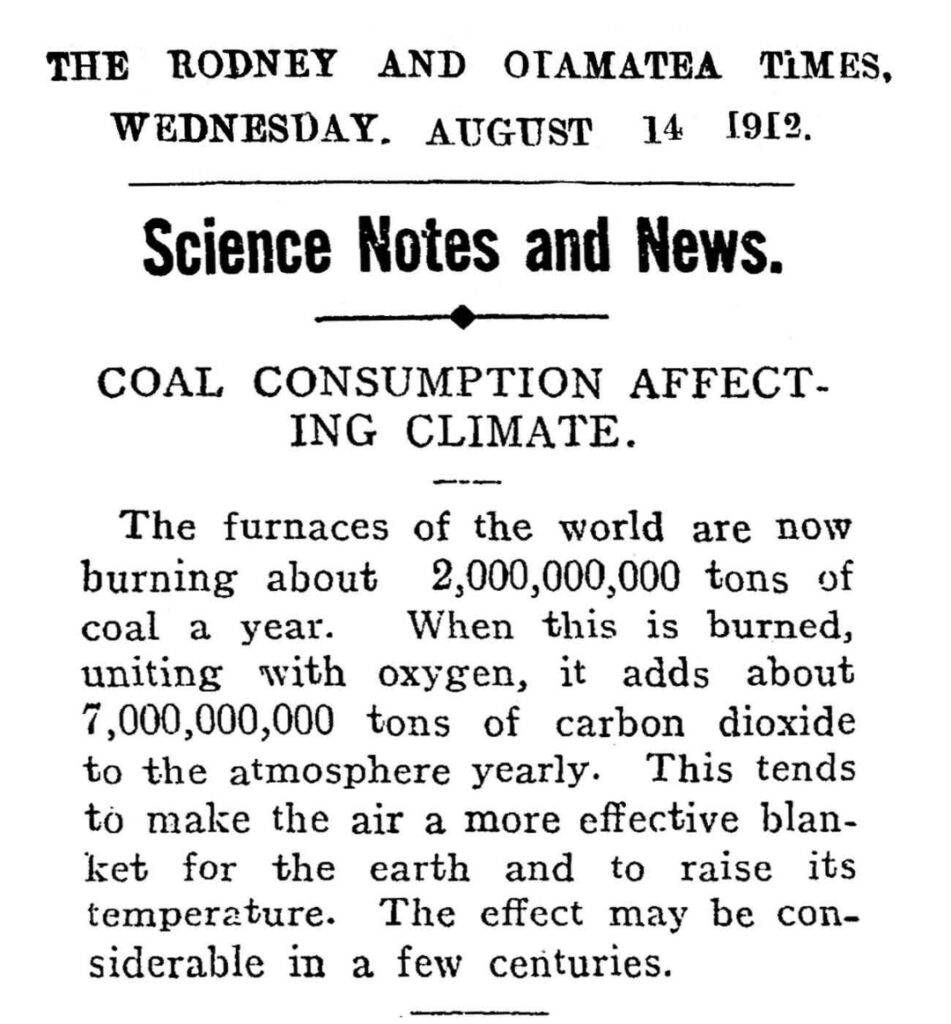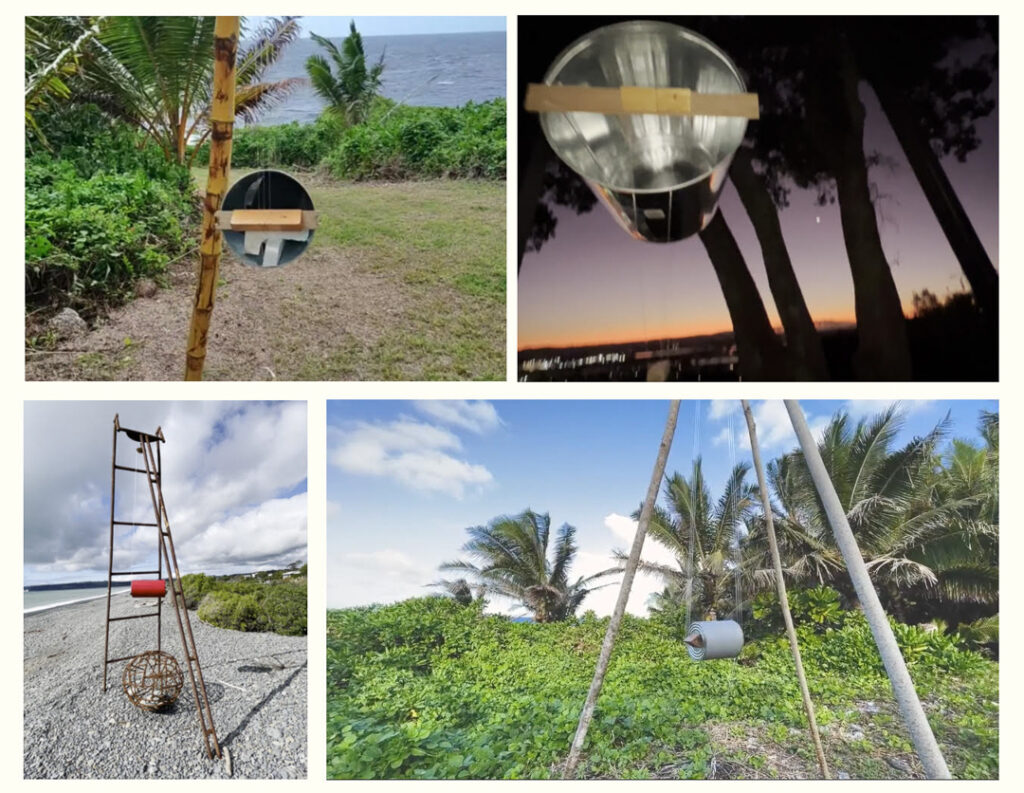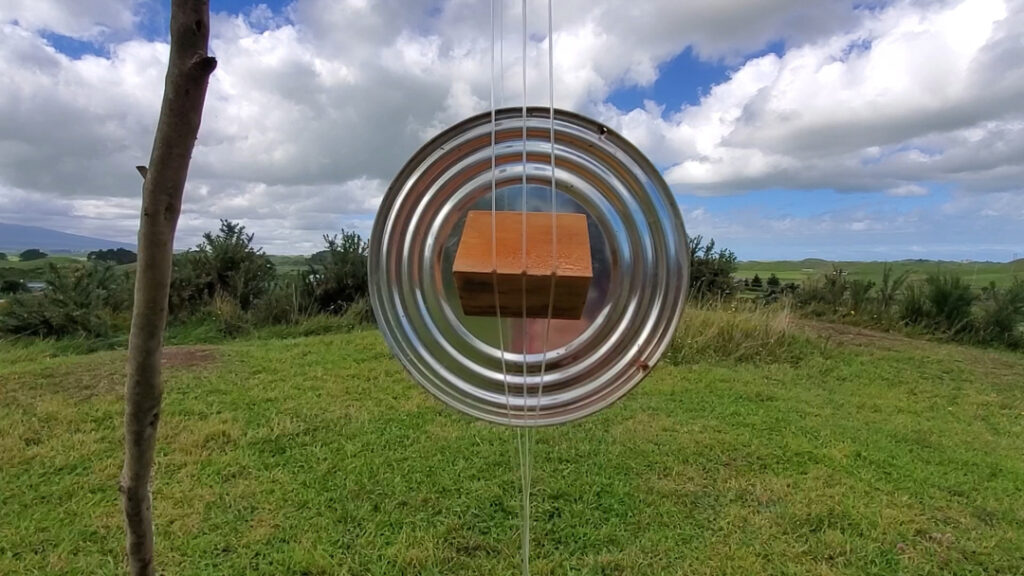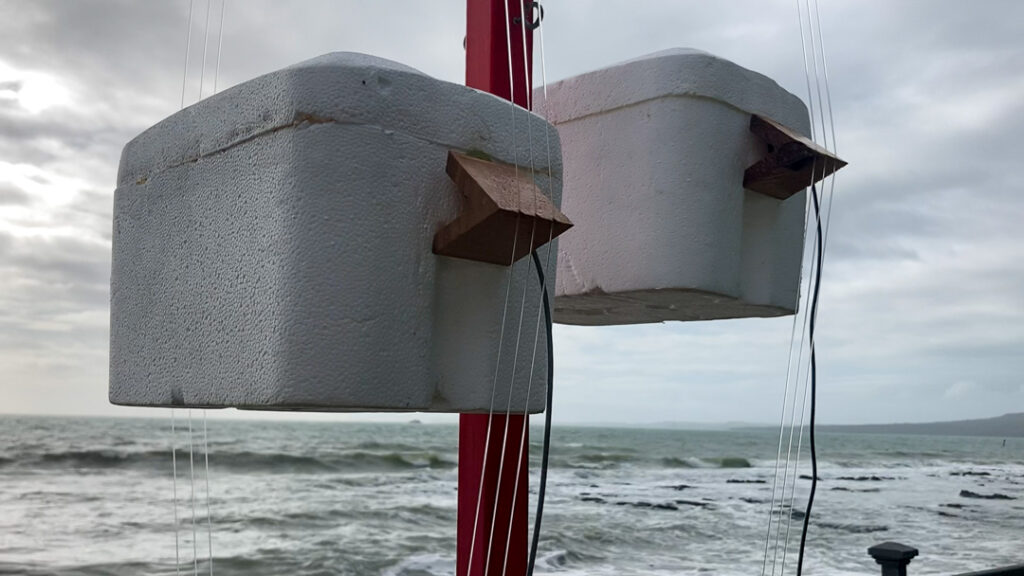Phil Dadson writes about the method of constructing aeolian harps that he developed for wind recordings across Te Moana Nui a Kiwa as part of the World Weather Network.
For we’re like creatures
In the wind
And wild is the wind
An excerpt from a 39’ duration sound work by Phil Dadson, commissioned by Pyramid Club 2022. An aeolian harp located on Rangitoto Island in the Hauraki Gulf (Tāmaki Makaurau-Auckland), installed and recorded during a week of different winds and weathers through mid-November 2022.
One of my passions, since the mid-1970s, is devising and performing with experimental musical instruments, so when an invitation came out of the blue to propose a project for an Aotearoa/Pacifica response to the World Weather Network initiative, the concept for a choir of aeolian (wind) harps evolved.
The idea of a wind driven instrument is an ancient one common to many cultures, most likely inspired wherever wind through vents or across dried strands of animal hide produced musical tones, squeals & screeches. Such observations eventually gave rise to string and pipe instruments created solely to reveal the beauty of harmonics produced by the action of wind and weather. Legend tells us that David, slayer of Goliath and King of the Israelites circa 1000BCE, hung a lyre above his bed at night to catch the harmonics of desert winds. In more recent times, Maori tell stories of beaches where rocks and stones with holes through them moan in the winds, voicing ancestors crying for their land.
World Weather Network is a two-year (2022/23) project originating from Art Angel in London, UK, to promote innovative perspectives on the global urgency of climate change around the planet. Te Tuhi Contemporary Gallery in Tāmaki Makaurau (Auckland) is one of some 30 global art-oriented venues worldwide invited to host projects. I was fortunate to be invited to propose one of the projects for a TeTuhi gallery website. It featured a concept for a choir of aeolian harps monitoring and recording (video/audio) wind and weather variables across diverse Aotearoa/Pacifica locations.
In early 2022, I invited participants from eight regional locations, north, south, east and west, within the South Pacific – Te Moana Nui a Kiwa (Maori for Pacific Ocean) to be part of the project. Collaborators were established in Tonga, Niue, Cook Islands, Samoa, and around the North Island coastline of Aotearoa/NZ, at Tāmaki Makaurau (Auckland), Whakatane, Haumoana and Taranaki. We named our distributed group “Breath of Weather Collective” and set out to realise the project across one year, solstice to solstice.

Te Moana Nui a Kiwa spans from Hawaii in the north to Rapanui/Easter Island in the east and Aotearoa/New Zealand in the south. Many islands in the region are already contending with the consequences of a warming planet due primarily to our exponential use of fossil fuels during the last two centuries since the industrial revolution. The Science Notes and News item reproduced above is alarming evidence that over a century ago, people were already wondering about the potentially harmful effects of coal-fired energy.
The idea was for the collective to use free-standing outdoor aeolian harp instruments to capture a wind-song record of changing daily conditions in different coastal communities. It is a poetic database and time capsule of climate change as it was, and is, being experienced.
Inspired in part by an aeolian harp design devised by artist friend and colleague John Cousins, I developed the Weather Choir harp to be sturdy, easily constructed and built in part using materials available at each location. A DIY kit of essential parts, including strings, bridges and resonators, was sent to each participant, with text instructions and an online video to aid its assembly.

clockwise from top-left: detail of aeolian harp at Island of Niue by Mark and Ahi Cross; detail of aeolian harp at Whakatane, Aotearoa New Zealand by James McCarthy; detail of aeolian harp at Rarotonga, Cook Islands by Te Ipukarea Society and Paris Tutty; aeolian harp at Haumoana, Aotearoa New Zealand by Dianne Reefman and Ricks Terstappen
Each harp is a simple, tall tripodic structure with two courses of three strings, attached at the apex and tensioned over wooden bridges set across both ends of a large resonator, which is an empty tin or bucket open at one end or a similarly hollow resonator such as a polystyrene box. The closed end of the resonator acts as a membrane that amplifies harmonic frequencies generated by a flow of air that sets the strings into vibration. The resulting frequencies are transferred via a pair of angular wooden bridges to each end of the amplifying resonator. String tension is achieved by hanging up to 20kg of weight below the resonator or by tensioning the string column into the ground. Participants need only to source the three leg lengths for the tripod, about 3.5 metres of bamboo or timber. One of my wind harps, for example, uses three old long wooden rowing oars.
With the tripod harp located to encounter prevailing winds, the instrument will begin to sing with even a slight breeze. Its alluring and eerie sound is a meter of variations in wind speed, direction and intensity. A breeze, a gust, a bluster, a tailwind, a sou’easter; all will generate a different effect across a spectrum of harmonics unique to each device and its location. The aeolian structure gives voice to the atmosphere, letting us hear the cries and warnings of the planet as it inevitably adapts to our human impact upon its ancient balance.
All recordings for this project, video and sound, were made with smartphones. Some of these sounds are recorded using a contact microphone attached to the resonator, and video documentation is made of the instrument as it sounds the winds. These recordings, all made with smartphones, create a bank of sonic and audiovisual data for use in exhibition presentations of the project.
Whilst the construction is intentionally minimal, there are many ways to customise and improve the sonic performance of a harp. The nylon strings can be washed with soap and water to improve their vibrational potential. The strings on either side of the resonator should be equally tensioned; the resonator should be horizontal. The position of the resonator up the column of strings, relative to the tripod apex, determines the fundamental note sounded by the strings, which in turn determines the complex harmonics generated by differing wind speeds.
The haunting mesmeric sounds of the harp evoke different sonic memories depending on the listener’s cultural heritage. For anyone with a history of watching science fiction films, listening to Eno’s music or noodling with synthesisers, the sound can be redolent of a Theremin, background music for empty ominous planet-scapes, or oscillator drones (which is precisely what they are, but analogue rather than digital).
Drone documentation of aeolian harp at Liku, Island of Niue by Mark and Ahi Cross
The recordings from each location make for intriguing listening. The technology of the contact mic has its idiosyncrasies, amplifying vibrations within the resonator membrane rather than vibrations through the air. When used to capture sounds from our aeolian harps, contact microphones push forward sounds made by the strings and mute or dampen nearby environmental sounds such as birdcalls, dogs barking, surf crashing, running water, etc.
But the contact mic will also amplify any sound made by other parts of the harp if the weights are knocking or scraping, or if a loose cable is flailing against a tripod leg. These sharp “less musical” sounds travel through the structure to the membrane and will also be captured, adding a sometimes strange but interesting juxtaposition with the voicing of the strings.
Eight harps were constructed and recorded for the project:
- In the Kingdom of Tonga by Uili Lousi & Kasimea Sika,
- in Samoa by Maina Vai and family,
- at Parihaka/Taranaki, Aotearoa by Pasha Clothier,
- at Whakatane, Aotearoa by James McCarthy,
- at Tāmaki Makaurau, Aotearoa, a set of harps by Phil Dadson,
- at Haumoana, Aotearoa by Dianne Reefman & Ricks Terstappen,
- at Rarotonga in the Cook Islands by Kelvin Passfield & Paris Tutty of Te Ipukarea Society,
- at Liku on the Island of Niue by Mark and Ahi Cross.
The urgency for raising global awareness about the regional impacts of climate change and extreme weather events is the prime catalyst for our project and all others under the banner of World Weather Network. Each harp in the choir is a metaphorical “body” of sorts, responding harmonically to the variables of wind and weather, consonant when calm, dissonant when wild. James McCarthy (Whakatane) draws a connection to ancient instrument technology and ancient weather systems, with the harp’s voicing of the weather as a symbol and a siren, warning that things are undoubtedly going awry.
The siren aspect of harp harmonics implies enchantment and an expansion of perception beyond the normal, allowing us to perceive the minutiae of weather variables in ways we might never otherwise. It awakens us to the gradually evolving reality of a global emergency unprecedented in human history, one that affects the entire population of all living species on the planet: climate change!
Weather Choir is one of six projects for online website presentations and an exhibition titled Huarere: Weather Eye, Weather Ear’, curated by Janine Randerson and hosted by Te Tuhi Contemporary Gallery in Tāmaki Makaurau / Auckland, Aotearoa. The exhibition is staged from June to August 2023.
Weather Choir : Koea o Tāwhirimātea from Phil Dadson on Vimeo.
About Phil Dadson
 Phil Dadson is a transdisciplinary artist, musician/composer, with a practice across video, sound, performance, drawing, building and performing with experimental musical instruments. He is the founder of the acclaimed NZ music/performance group From Scratch. He lectured in Intermedia at the Elam School of Fine Arts from 1977, leaving in 2001 to take up full-time art practice. In 2015, the feature film Sonicsfromscratch, documenting Dadson’s career, premiered at the New Zealand International Film Festival. Awards include 2001 Arts Foundation Laureate, ONZM, Antarctic Artist Fellowship, Fulbright-Wallace Headlands residency. Dadson is represented by Trish Clark Gallery, & Circuit.org.nz. He lives in Tāmaki Makaurau / Auckland, Aotearoa/NZ. Visit trishclark.co.nz/artists/dadson-phil/ and www.circuit.org.nz/artist/phil-dadson.
Phil Dadson is a transdisciplinary artist, musician/composer, with a practice across video, sound, performance, drawing, building and performing with experimental musical instruments. He is the founder of the acclaimed NZ music/performance group From Scratch. He lectured in Intermedia at the Elam School of Fine Arts from 1977, leaving in 2001 to take up full-time art practice. In 2015, the feature film Sonicsfromscratch, documenting Dadson’s career, premiered at the New Zealand International Film Festival. Awards include 2001 Arts Foundation Laureate, ONZM, Antarctic Artist Fellowship, Fulbright-Wallace Headlands residency. Dadson is represented by Trish Clark Gallery, & Circuit.org.nz. He lives in Tāmaki Makaurau / Auckland, Aotearoa/NZ. Visit trishclark.co.nz/artists/dadson-phil/ and www.circuit.org.nz/artist/phil-dadson.
The artist gives thanks to Gary Warner for invaluable assistance with assembling the article.



